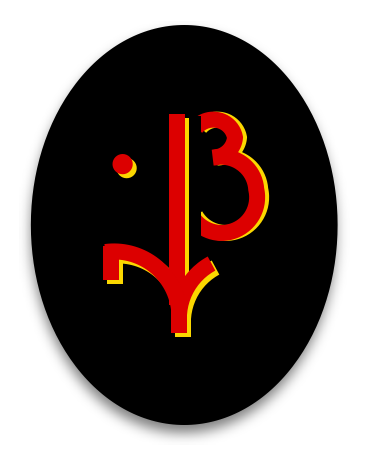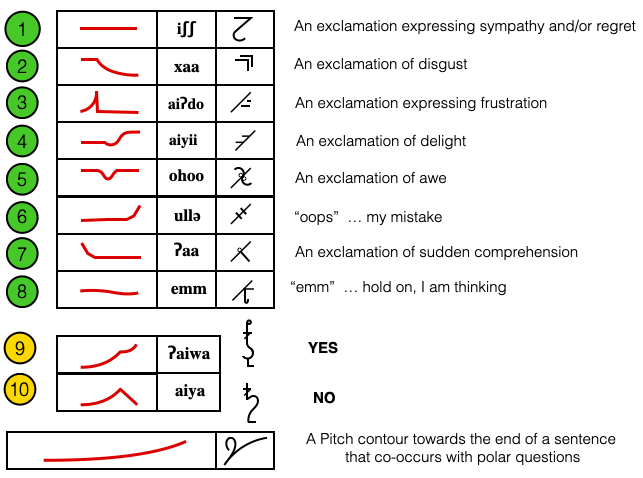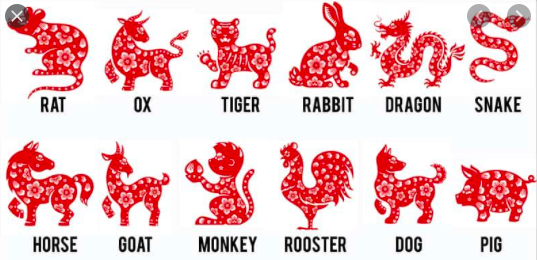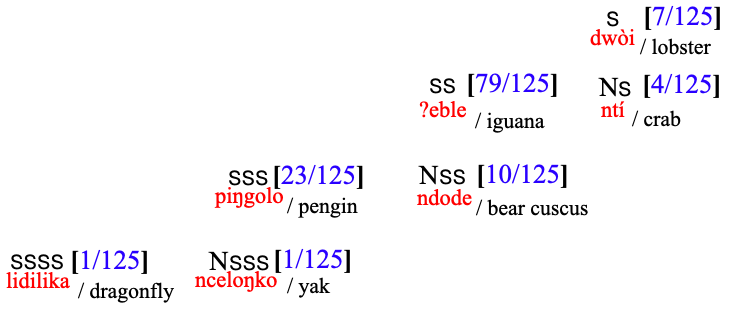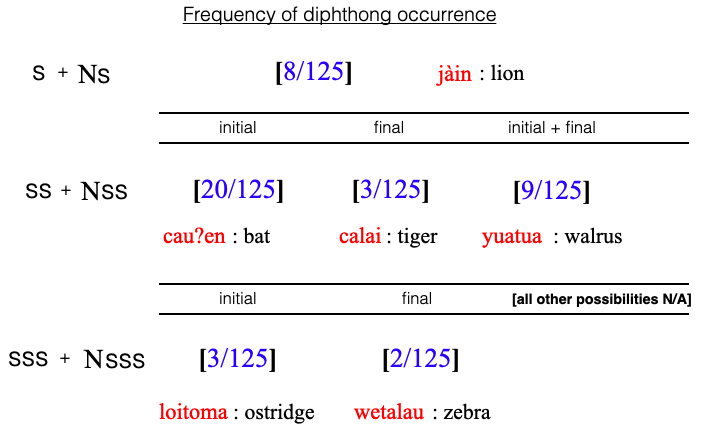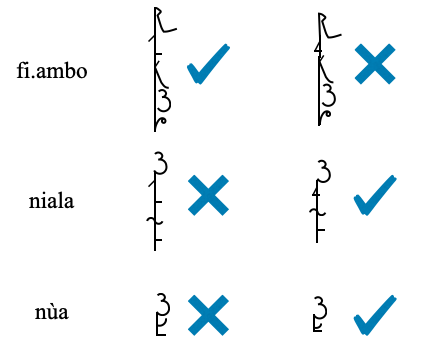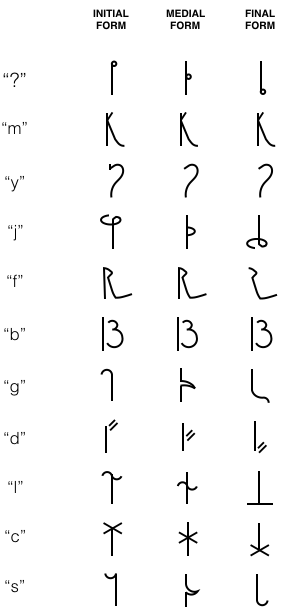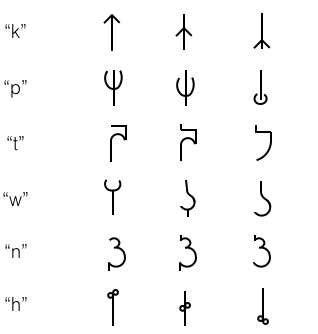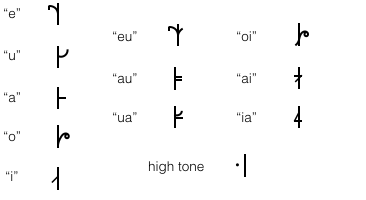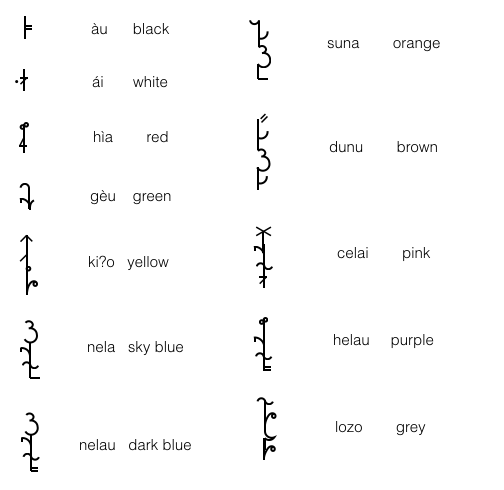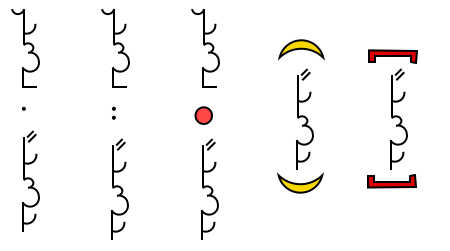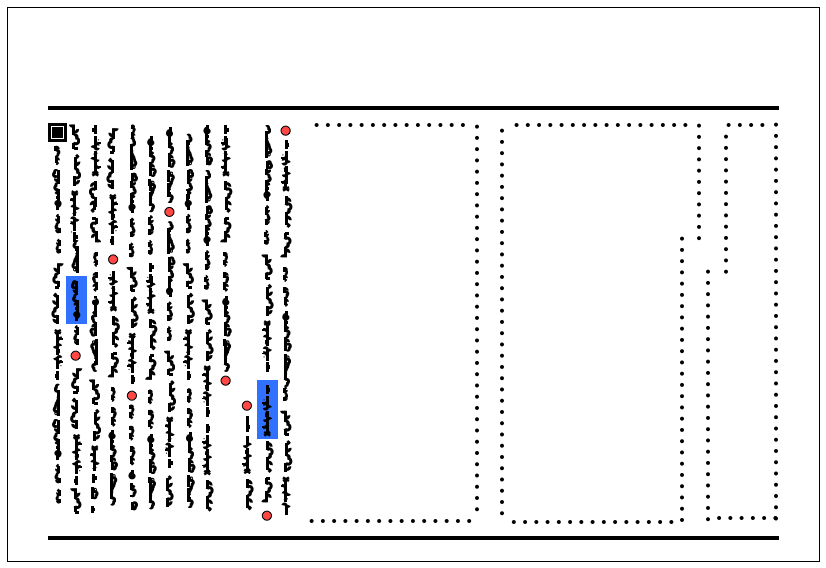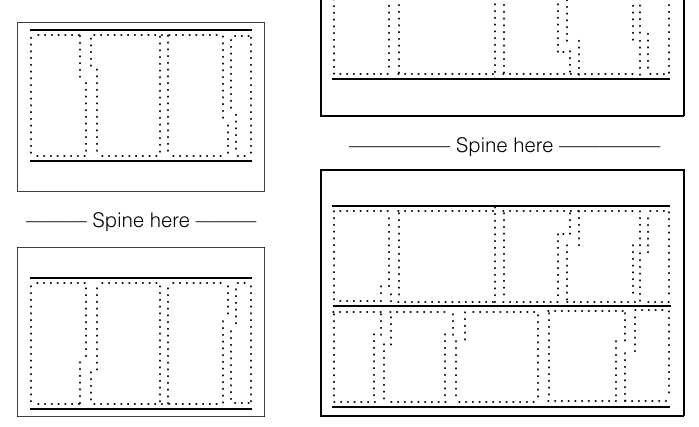Béu : Chapter 1 : The Sounds
Contents
..... The sounds of béu
..
The full range of sounds heard in béu are given below according to the conventions of the International Phonetic Alphabet (I.P.A.).
..
| labial | labiodental | alveolar | postalveolar | palatal | velar | glottal | |
|---|---|---|---|---|---|---|---|
| stops | p b | t d | k g | ʔ | |||
| fricatives | f v | s z | ʃ ʒ | x | h | ||
| affricates | tʃ dʒ | ||||||
| nasals | m | n | ŋ | ||||
| liquids | r l | ||||||
| glides | w | y |
tʃ dʒ are the initial sounds of "Charlie" and "Jimmy" respectively. From now on they will be represented by c and j.
ʔ represents a glottal stop (the sound a cockney would make when he drops the "tt" in bottle). In béu this is a normal consonant ... just as real as "b" or "g" in English.
x is an allophone of h occurring in coda position.
v is an allophone of f when inside a word and between two vowels. In writing I will continue to use f to represent this allophone as v is visually indistinct next to any vowel.
z is an allophone of s when inside a word and between two voiced sounds.
ʃ is also an allophone of s when before the front vowel i. ʃ is found in English and is usually represented by "sh" (as in "shell")
ʒ is an allophone of s when the above two conditions apply at the same time. ʒ turns up in English in one or two words. It is the middle consonant in the word "pleasure".
ŋ is an allophone of n when followed by k or g. ŋ is found in English and is usually represented by "ng" (as in "sing").
l is a clear lateral in all environments.
r is an approximant in all environments.
p, t and k are never aspirated. And on the other hand b, d and g are more voiced than in English (i.e. the voice onset time is a lot earlier)
..
The béu phoneme inventory is shown below.
..
| labial | labiodental | alveolar | postalveolar | palatal | velar | glottal | |
|---|---|---|---|---|---|---|---|
| stops | p b | t d | k g | ʔ | |||
| fricatives | f | s | h | ||||
| affricates | tʃ dʒ | ||||||
| nasals | m | n | |||||
| liquids | r l | ||||||
| glides | w | y |
There are 5 basic vowels ... a, e, i, o, u plus ə. However the schwa is only used in the grammar and does not appear in any actual words. There are 6 diphthongs ... ai, au, oi, eu, ia and ua. Note that while the sounds ia and ua are possible sound combinations in English, they each are realised as two syllables. In béu the two components are more intertwined ... they flow into each other more. And they each represent only one syllable. Certain people pronounce e and o more open, when they occur at the end an open syllable, but for others, e and o are the same in all environments.
..
béu differentiates between words using tone. All single syllable words have either a high tone (for example pás = "I") or a low tone (for example pà = "me"). All multi-syllable words lack tone (or can be said to have neutral tone). If a single syllable word, receives an affix making it into a multi-syllable word, its tone will become neutralised. If a word count was done on a typical béu text, it would be found that around 17% of words have a high tone, 33% have a low tone and 50% have the neutral tone.
..
For non-monosyllables the main stress is always on the first syllable, and it is articulated by adding approximately 100 ms more length to the stressed vowel. Stress does not cause any measurable modifications in vowel quality. Stress is never strong. In this regard béu is like the languages descended from Latin ,,, and unlike the slavic languages.
..
Don't let the tones put you off learning béu. The chances are vanishingly small that you will cause a misunderstanding by pronouncing one of the short words wrong. And even if you speak the language and put absolutely no effort into getting the tones right ... no problem, it will just mark you out as a non-native speaker, you will be understood virtually all the time.
..
In the béu writing system a small dot is placed to the right of the word if it has a high tone. If single syllable words are come across that do not have a dot .... well then you know that they must be low tone.
IMPORTANT ... A glottal stop is never inserted before a word-initial vowel.
..
..... Some interjections
..
All languages have a small set of interjections. Often these words fall outside the normal phonology of the language ; béu is no exception. These words are normally elucidated singly. Also they usually have a set pitch contour. The pitch contours of the interjections below are shown by the red lines and the interjection is shown in the next column in IPA (well ... sort of IPA). These interjections also have their own symbol.
..
..
These words break the normal rules of béu phonology by ... (1) ʃ usually only occurs before i plus usually no consonants have double length (2) "x" (the sound in "loch) usually doesn't occur plus usually no vowels have double length (3) the glottal stop is usually not syllable final (4) the final i has double length (5) the final o has double length plus ... the initial o is longer than usual (6) the length of the l is longer than usual. In fact it is quite variable. Especially these days where you have video action replays. The commentator tends to match the length of the l to the length of the fail. Actually this interjection is probably related to the verb ulpa which means to make a mistake ... often used as the first element of a SVC to give a meaning similar to "mis" in "mis-hit" or "mis-pronounce" (7) ... ʔaa / ʔaaa ... usually no vowels have double or treble length (8) emm / eemm / mmm ... this consonant is not normally syllable final, the consonant is double length, the vowel can be double length on occasion.
..
(9) and (10) are not normally considered interjections. However ʔaiwa is said when some good news materializes (compare to English "YES !" or "Oh yeah"). Also aiya is said when some bad news materializes (compare to English "Oh No").
(11) is not an interjections. But is included here as it breaks the normal tone rules.
..
(9) ... ʔaiwa meaning "yes". When said in isolation (i.e. nearly always) it takes a definite tone conture.
(10) ... aiya meaning "no". When said in isolation (i.e. nearly always) it takes a definite tone conture.
(11) ... ʔai is a sentence final yes/no question particle. Now other mono-syllables have either a high tone or a low tone. This one has a tone conture. From now on I will transcribe this as ? ... to stop it being confused with ?ài or ?ái.
ʔaiwa and aiya are written as words normally are. However ʔai with its rising contour is given a special sign. In my transcription of this sound, I will use ʔai? ... well I can not honestly transcribe it as either ʔài or ʔái.
(9), (10) and (11) are often hummed. As all three have a unique tone contour, they are readily understood if hummed. [I am not sure if there is a way to transcribe (9), (10) and (11) when hummed]
..
There are two other words that can be called interjections. To encourage somebody that is physically straining in some task or competition you would say uhozo. Likewise exhorting/encouraging is yala ... meaning "come on" or "let's go". Actually copied from an Arabic word with the same meaning ... it fits in very neatly with béu morphology.
By the way ... as well as ʔaiwa and aiya being suitable responses to an ?ai? question, waron is often found [ I think so ]. Less commonly found is waron aiya [ I think not ]
[ Note to self : what president does this set for complementation ? ]
..
Note ... there are no exclamations for Anger, Displeasure or Embarrassment. These emotions are suffered in silence. Related to the aforementioned is the fact that béu is a languages that has no swear words.
..
..... Consonant clusters
Word initial
..
The following consonants and consonant clusters can be found at the beginning of a word ;-
| ʔ | | | |||||||||
| m | my | | | mb | mp | ||||||
| y | | | |||||||||
| j | jw | | | ||||||||
| f | fy | fl | | | |||||||
| b | by | bl | bw | | | ||||||
| g | gl | gw | | | |||||||
| d | dw | | | ||||||||
| l | | | |||||||||
| c | cw | | | ||||||||
| s/ʃ | sl | sw | | | |||||||
| k | ky | kl | kw | | | ||||||
| p | py | pl | | | |||||||
| t | tw | | | ||||||||
| w | | | |||||||||
| n | ny | | | nj | ŋg | nd | nc | ŋk | nt | ||
| h | | |
Above are 45 consonants/consonant-clusters. Actually there is a zero option as well. For example àu (black). So we can say there are 46 possibilities (1146). The 37 on the LHS have a nice pattern to their distribution. The 8 on the RHS have syllabic nasals as their initial element.
The eight intitial to the right can can give rise to single syllable words (for example mpò "dove". So I guess I should not call the nasals, syllabic nasals. Rather I should refer to the stops and call them prenasalized stops.
..
Word medial
..
The following consonants and consonant clusters can be found in the middle of a word ;-
| ʔ | m | y | j | f | b | g | d | l | c | z/ʒ | k | p | t | w | n | h |
| lʔ | lm | ly | lj | lf | lb | lg | ld | -/- | lc | lz/lʒ | lk | lp | lt | lw | ln | lh |
| nʔ | -/- | ny | nj | nf | mb | ŋg | nd | -/- | nc | nz/nʒ | ŋk | mp | nt | mw | mn | nh |
| sʔ | zm | ʒy | -/- | sf | zb | zg | zd | zl | -/- | -/- | sk | sp | st | zw | zn | sh |
Above are 62 medial consonants/consonant-clusters. Actually there is a zero option as well. For example kli.o (knife). So we can say there are 63 possibilities (1436).
Notice that -mn- is allowed but -nm- is not.
Also it would be strange to disallow consonant clusters which are allowed word initially, so we must add my jw fy fl by bl bw gl gw dw cw ky kl kw py pl and tw.
So 80 possibilities (2126).
..
Word final
..
The consonants n, s, r and h can occur word finally. However no basic words end in r and h. When r occurs word finally it is showing a certain conjugation, and when h occurs word finally it is showing a certain inflection.
..
..... Vowels
..
The vowels and diphthongs are ... ai e eu u ua a ia i oi o and au.
If two vowels are adjacent to each other and do not follow the pattern ai eu ua ia oi or au then they belong to different syllables. An example of this is byoas meaning "cobra". Sometimes in this situation I will insert a period to make this clear .... byo.as. In a very small number of words, two vowels are adjacent to each other and DO follow the pattern ai eu ua ia oi or au. An example of this is fi.ambo meaning "frill-neck lizard". I will ALWAYS insert a period in these situations.
..... Word structure
..
To get an idea of the word structure of the language it is good to look at the toze. A toze is an animal emblem that can be considered to preside* for a year. Quite similar to the group of animals that the Chinese use for their 12 years cycle. The toze are representative of the béu nouns structure for the most part.
..
..
There are 125 toze. They come from every place and time ...
..
| ?eble | iguana | ?usfa | giraffe | ?inte | ant | ?intebian | anteater | melba | gecko | |
| mazna | lemur | mias?a | Steller's sea cow | moa | moa | myata | duck | myolan | swan | |
| mbu?o | badger | mboza | hyena | mpaipe | spider | mpò | dove | yeme | frog | |
| yuatua | walrus | yizgi | black skimmer | yoihu | swordfish | jàin | lion | jambe | pelican | |
| jolomo | mole | jo?ila | cheetah | jwufu | triceratops | jwí | rabbit | felu | jackal/fox | |
| juages | opossum | fanfa | horse | fi.ambo | frill-neck lizard | fyake | springbok | wombana | kangaroo | |
| fleu?en | falcon | flimi | snail | bazlin | wolverine | badwa | bullfinch | biabia | butterfly | |
| baumal?o | gnu/wildebeest | byema | cape buffalo | byoas | cobra | bletus | auroch | blauna | Irish Elk | |
| bwebwe | humming bird | bwo?uma | colossal squid | gaifai | flamengo | guputa | parrot | gialti | glyptodon/doedicurus | |
| goizon | chameleon | glufan | driprotodon(wombat) | gloyun | hornbill | gwúa | python | gwía | gemsbok | |
| demotis | gorilla | dalpan | capybara | dospondo | aardvark | daugomo | porcupine | dwolhe | crocodile/alligator | |
| dwòi | lobster | lea | red panda | launga | jaguar/panther | lidilika | dragonfly | loitoma | ostrich | |
| celigo | hedgehog | caltin | lama | calai | tiger | cau?en | bat | cwemen | whale | |
| cwitopa | octopus | seloki | lynx | sadu | elephant | salubi | megatherium | ʃinti | squirrel | |
| slaikan | cormorant/shag | slianiŋki | chimpanzee | sweton | wartho | swoljo | musk oxe | kaimyai | vulture | |
| kendo | goat | kuakua | seahorse | kiampi | seal | kiwon | rhino | kaukwa | grouse | |
| kyohazlo | praying mantis | klekle | cicada/cricket/grasshopper/locust | klozo | hawk | kwuha | polar bear | kwono | raccoon | |
| paibian | panda | palbuma | T-rex | pikau | peacock | pingolo | penguin | pyès | manta ray | |
| pyiaʒi | meerkat/mongoose | plantos | weasel/ermine/stoat/mink | plona | NA bison | tufla | beatle | tiaŋgo | dolphin | |
| tostuya | beautiful armadillo | tauta | shark | two?a | bear | wenye | scorpion | wetalau | zebra | |
| wolos | glyptodon/doedicurus | waulo | wolf | negus | woolly mammoth | nùa | rat/mouse | niala | kingfisher | |
| nozdi | beaver | njele | raven/crow | njogo | seagull | ŋgulo | owl | ŋgohis | crane/stork/heron | |
| ndode | bear cuscus | nceloŋko | yak | ncoin | deer | ŋkele | swift | ŋkaus | baboon | |
| ntiga | smilodon | ntí | crab | nyafi | okapi | nyauti | pangolin | hailai | toucan | |
| habian | bee | huatua | turtle/tortoise | haulau | eagle | ujama | camel | ozgin | puffin |
If you analyse them, it can be seen that just over 15% have a final -n and just under 5% a final -s.
..
Over 10% have pre-nasals.
..
Over 50% are bi-syllabic, followed by tri-syllabic, followed by monosyllabic.
..
Here is a breakdown of the toze soundshape ....
S = monosyllabic SS = bi-syllabic etc. etc.
N = a pre-nasal
The béu toze is in red and the English translation is in black. In brackets is the total occurrences out of the 125 samples.
..
The above gives some idea of what a noun looks like. Verbs look pretty much the same.
Adjectives have an even greater percentage of "SS" (bi-syllabic) forms. Most have the structure "CVCV" (as in ki?o "yellow").
Particles are mostly monosyllabic (as you would expect from Zipf's law).
..
And what about diphthong distribution ? Well here is a toze breakdown ...
..
..
SS words having two diphthongs (like yuatua) is definitely a toze thing. This pattern is a lot rarer among normal nouns.
In fact the whole middle row does not represent well the béu nouns situation. The numbers for nouns in general would be [15/125] : [10/125] : [ 5/125] instead of [20/125] : [3/125] : [ 9/125].
When it comes to SS adjectives, around 15% have a diphthong as their final vowel.
And more notable yet, when it comes to verbs, more than 30%** have a diphthong as their final vowel.
..
* A chinese totem presides for exactly one year. A toze presides for slightly more than a year ... 374 days in fact.
** In Ch 3, "Infinitives" it says 36% of verbs end in a diphthong ... 9% each for ai eu oi au
..
..... Syllabification
..
In the table of toze above, it can be seen that I sometimes insert a period inside a word (i.e. fi.ambo). This is to properly define how many syllables a word has. Most languages don't offer the syllabification choices of béu. The nearest example I can think of is the word "gaucho" (South American cowboy). Everytime I have heard it pronounced in the UK Iit was pronounced as a two syllable word. However, in Brazil, where the word comes from, it is pronounced as a three syllable word ... ga - u - cho. If the occasion arises and "gaucho" must pass my lips, I must decide which pronounciation to use (probably I will decide on the basis of how "international" my audience is).
So when I use the Latin alphabet to transcribe the béu language, sometimes inter-word periods are necessary. When using the thread writing no such confusion can occur ...
No inter-word periods are necessary in words such as lea and moa. As ea and oa are not diphthongs there can be no ambiguity. These ARE two syllable words.
Another example is iyo.ito(itsy-bitsy, tiny). This is a 4-syllable word. Without the dot it would be a 3-syllable word. Of course when written in the béu script there is no ambiguity.
..
..... Plurality
..
The following transformations make a plural noun out of a singular one ...
..
| gaifai | flamenco | => | gaifai.a | flamencos |
| ?eble | iguana | => | ?ebleu | iguanas |
| sadu | elephant | => | sadua | elephants |
| ntiga | smilodon | => | ntigai | smilodons |
| ʃinti | squirrel | => | ʃintia | squirrels |
| kendo | goat | => | kendoi | goats |
| wetalau | zebra | => | wetalau.a | zebras |
..
You may have noticed that I have not mentioned any transformation to make nouns ending in -eu or -oi into plurals. The reason for this is that we don't have any nouns ending in -eu or -oi .
..
In béu whether a word has a plural form or not depends solely on what sounds are at the end of the word. Three conditions preclude a word from having a plural ...
1) Single syllable words.
2) Words ending in "n" or "s".
3) Words ending in "ia" or "ua".
..
In English two animal names lack a plural ... "sheep" and "deer". If you look back at the 125 toze, 40 of them have no plural form. This is about one in three. This ratio is similar for nouns in general. About one third of nouns have no plural form**.
..
A small group of words (just these twelve listed below) have a special dual form ...
| wá | eye or eyes | wáu | a pair of eyes | ||
| mbà | arm/hand or arms/hands | mbàu | a pair of arms/hands | ||
| elza | ear or ears | elzau | a pair of ears | elzai | ears |
| kaupa | leg/foot or legs/feet | kaupau | a pair of legs/feet | kaupai | legs/feet |
| gluma | breast or breasts | glumau | a nice pair | glumai | breasts |
| jwuba | a buttock or buttocks | jwubau | an arse | jwubai | buttocks |
| ploka | cheek or cheeks | plokau | a pair of cheeks | plokai | cheeks |
| olna | shoulder or shoulders | olnau | a pair of shoulders | olnai | shoulders |
| kloga | shoe or shoes | klogau | a pair of shoes | klogai | shoes |
| noda | nostril or "blow hole" or nostrils | nodau | a pair of nostrils | nodai | nostrils |
| ilkuma | tusk or tusks | ilkumau | a pair of tusks | ilkumdai | tusks |
| olata | antler | olatau | a pair of antlers | olatai | antlers |
..
Like all languages, béu has a few irregularities. Logically you would think pembe "horn" should pattern with olata. However it doesn't, it lacks a special dual form [perhaps because kiwon have pembe as well as lata, but kiwon has a single one]
..
A sizable group of words (perhaps one or two hundred) have a special singular form. Some examples from this group ...
..
| yinki | crumpet | yinkai | a young unmarried woman, an attractive girl, a virgin |
| toti | children | totai | a child |
| wazbo | distance | wazbai | 3,680 m (the unit of distance ... the béu km or mile) |
| malkufa | cabbages | malkufai | a cabbage |
| alha | flowers | alhai | a flower |
| fiŋko | clothes | fiŋkai | an item of clothing |
| taikuli | testicles | taikulai | a testicle |
..
... all the base forms above have a collective meaning ... they are all uncountable or "mass" nouns.
Also two -ai words seem to be derived from maŋga : lelpa = to sing => lelpai = a song : lento = to play => lentai = a match, a game
Like all languages, béu has a few irregularities. Logically you would think taikuli should pattern with olata. However it doesn't, it lacks a special dual form.
..
And the 7 words have irregular plurals ...
| pú | person | mpú | people |
| bàu | man | bawa | men |
| glá | woman | gala | women |
| dà | place | ndà | places |
| cái | fairy * | cai.a | fairies |
| nò | number | nòi | numbers |
| yé | year | yéu | years |
..
And maybe this would be a good place to mention páu and conau.
pú = "person"
páu = "two people" or "a couple" (not necessary married but the word gives a very strong connotation that the couple are intimate/having sexual relations)
con = a derivative suffix meaning "one of two"
conau = "parents"
..
* Actually a fairy-like creature. It is the only supernatural creature in the culture of béu ... so no elves, dwarves, goblins etc. etc. cai.a on the whole are neutral as far as the good/bad continuum is concerned although certain individuals are considered naughty and other individuals are considered kindhearted.
..
** A noun with no plural form is unspecified as to singular/dual/plural.
However if the noun is the subject of an active clause, plurality will be shown by whether o or u is in the verb-tail.
Of course you can add words to modify the bare noun if you want to be more specific as to number.
The addition of yè [see Ch2, Quantity] is the nearest béu equivalent to the plural form in a language in which the singular/plural distinction is mandatory.
Actually in a large number of situations, this strict singular/plural distinction serves no purpose. However if your natlang has such a distinction it is hard to get rid of the idea that the singular/plural contrast is always essential.
..
..... Thread writing
..
béu has 17 consonants.
For some of these the form differs slightly, depending upon whether the letter is at word initial, word medial or word final.
The three forms are shown below.
..
béu has 5 vowels and 6 diphthongs.
The form of these doesn't change with their position.
These are shown below.
..
..
To give you better idea of what thread writing looks like, I have listed below the 12 colours of béu.
..
..
Nice, eh ... sort of organic
..
..... Saying the letters
..
When speaking out the letters, each letter has a word associated with it. This is a bit like when we say "sierra tango echo ..." to spell out a name over the telephone.
| letter | associated name | meaning |
| ʔ | ʔusfa | a giraffe |
| m | moŋgo | a gibbon |
| y | yeme | a frog/toad |
| j | jambe | a pelican |
| f | fanfa | a horse |
| b | biabia | a butterfly |
| g | gaifai | a flamenco |
| d | duzu | an oryx |
| l | lata | a cow |
| c | compa | a palm tree |
| s | sadu | an elephant |
| k | kiŋki | a fir tree |
| p | pikau | a peacock |
| t | tauta | a hammerhead shark |
| w | wenye | a scorpion |
| n | nùa | a mouse/rat |
| h | habian* | a bee |
We use a different system for the vowels. We add the vowel to san to speak out the vowels. For example ...
To spell naike (sharp) we would say nùa sanai kiŋki sane dù
To spell a vowel that has left.dot (high tone) you substitute dit for san. For example ...
wías (we) would be spelt wenye ditia sadu dù
r is designated by huka (which means hook)
dù is a particle, used with numbers and when spelling, that indicates you have finished a word.
Note ... there is a word dito which means "dot" or "point". Also there is a word santai which means vowel.
táu = letter, character, "symbol used to represent a sound, syllable, word or number"
When a letter is mentioned by itself ( i.e. not as part of a string) it takes the form produced by word building with the above. For example ...
táu gaifai = the symbol given to the sound "g" in béu
táu nùa = the symbol given to the sound "n" in béu
..
* This word has an interesting etymology. alha = flower : alhabian = the one attracted to flowers
So habian can be seen to be a rubbed down version of alhabian
..
... Printing
..
Punctuation and Page Layout
..
The letters in a word are always contiguous, that is there is always a line running right through the word. Writing is primarily from top to bottom and secondarily from left to right.
Between words there is a small "break" in the line. The break should be 25% the height of a letter.
Between some words there is a gap. This represents a pause. In béu every place an orator draws breath (or could draw breath) should be reflected in the writing system with a "gap". A gaps hould be 75% the height of a letter.
There are occasions where the grammar of béu demands a gap. I will represent in in my transcription as an underscore.
Side Note ... [ Presumable in English, commas originally were always used for pauses in speech. However nowadays in English many pauses are not represented in any way ... in these places when comma's are not necessary for reading comprehension. Also in English, in a surprising amount of text comma's are found where they shouldn't be. ]
Side Note ... [ When listing items, béu is similar to English ... there is pause between every item except the last two items. Between these items, béu has lé and English has "and" ]
..
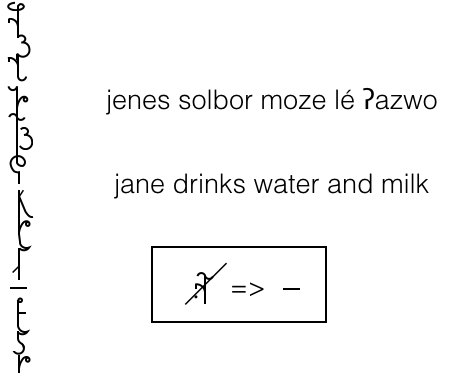 ............................... suna_dunu_celai lé àu = "orange, brown, pink and black" ... [ notice the 2 gaps and the 2 breaks in the béu script ]
............................... suna_dunu_celai lé àu = "orange, brown, pink and black" ... [ notice the 2 gaps and the 2 breaks in the béu script ]
..
By the way, this would be spelled out as ... sadu sanu nùa sana jù_duzu sanu nùa sanu jù_compa sane lata sanai dù_táu lé_sanau dù dù ... [ dù for a break and jù for a gap ]
Note that the word lé has a special symbol ... táu lé. There are about 30 common words that have short-hard symbols. They are never written out in full.
..
Single gaps are very common. Occasionally you can have "double gaps" and even "treble gaps". These rare creatures represent "pregnant pauses" which are sometimes used for comic effect.
Note the single point used in the "double gap" and the pair of points used in the "treble gap".
For a "double gap" there should be 75% letter height space above and below the dot. For a "treble gap" it is the same 75% letter height above and below the dots plus a 25% letter height between the dots.
There is also a punctuation mark called the koipa "sunmark" ( kòi = sun faspa = mark koipa = "sunmark" ) ... always red infill. This is basically a full-stop. The koipa has double the diameter of omba (omba means "circle" and is used as a decimal point).
There are also punctuation marks called deupa "moonmark" ( dèu = moon faspa = mark deupa = "moonmark" ) ... always gold infill. These are basically brackets. The opening one is called deupa damau and the closing one is called deupa dagoi.
..
..
The deupa are solely used as quotation marks. For other sorts of bracketing the form shown above on the RHS should be used. .......... to be named ... "above shelf" / "below shelf" ???
Usually everything is written in "textblocks". Three and a bit "textblocks" are shown on the demonstration page below ... [ I could note be arsed wording all the textblocks, so reverted to dotted lines towards the RHS ]
..
This is the first page in a "chapter" in a paperback book. Notice the symbol at the top left hand side of the first "textblock". This is called a "tile" and is always the first thing in a chapter.
Textblocks fit in between "rails" (the dark horizontal lines) about 4 inches apart. The width of a block should be between 60% and 90% * of the block height. Of course it is best to start a new block when the scene of the narrative changes or there is some other discontinuity of the action, but this is not always possible. One then just must arbitrarily split the text into two blocks. The standard practice is to stretch the text a bit so that the tops and bottoms of every column line up.
There is no way to split a word between two lines as we can do in the West by using two hyphens. A koipa starts of every textblock.
The first text block starts at the top left (as you would expect). The second textblock starts below where the first text block stops. In fact the vertical space between the stop and the start of the two textblocks is equal to the horizontal "interblockspace"). Between textblocks there is a one culumn gap.
In every textblock, one word or short noun phrase is highlighted in blue. The shape of the highlighted area is rectangular with rounded edges. Usually a noun is chosen and the more iconic the better. Statistically these highlighted words tend to come towards the beginning of the "textblock".
There are two sizes for books. For all hardback books the size is about 8 inches by about 11 inches. For all paperback books the size is about 5 inches by about 8 inches. They are stored as shown in the figure below.
..
..
Unlike books produced in the West, these books are held with the spine horizontal when being read. The hardback page has two "rails" per page (i.e. three dark horizontal lines instead of two).
..
..
On the paperback book, the title is written on the spine and on the front of the book. On the hardback book the title is written on the front, also there is a flap that slides into the spine. However when the book is stored on a shelf, it is pulled out and hangs down. Hence the hardback books can be easily located, even when they are in the bookshelf.
A book will be divided into chapters. A chapter will have a number and usually a title as well. Either at the end of the book or just after the chapter, there will be a page, in which all the highlighted words for a chapter are listed in order. Instead of referencing things by page number, things are reference by chapter and textblock (indictated by the highlighted word(s) ).
Any particular word in a book can be reference by 5 parameters ...
1) "title of book"
2) number of the chapter .... will perhaps have a title as well
3) the highlighted word(s) ... these will be numbered ... [ number corresponds to textblock ]
4) the number of koipai passed.
5) the number of the word in the sentence
..
... Index
- Introduction to Béu
- Béu : Chapter 1 : The Sounds
- Béu : Chapter 2 : The Noun
- Béu : Chapter 3 : The Verb
- Béu : Chapter 4 : Adjective
- Béu : Chapter 5 : Questions
- Béu : Chapter 6 : Derivations
- Béu : Chapter 7 : Way of Life 1
- Béu : Chapter 8 : Way of life 2
- Béu : Chapter 9 : Word Building
- Béu : Chapter 10 : Gerund Phrase
- Béu : Discarded Stuff
- A statistical explanation for the counter-factual/past-tense conflation in conditional sentences
